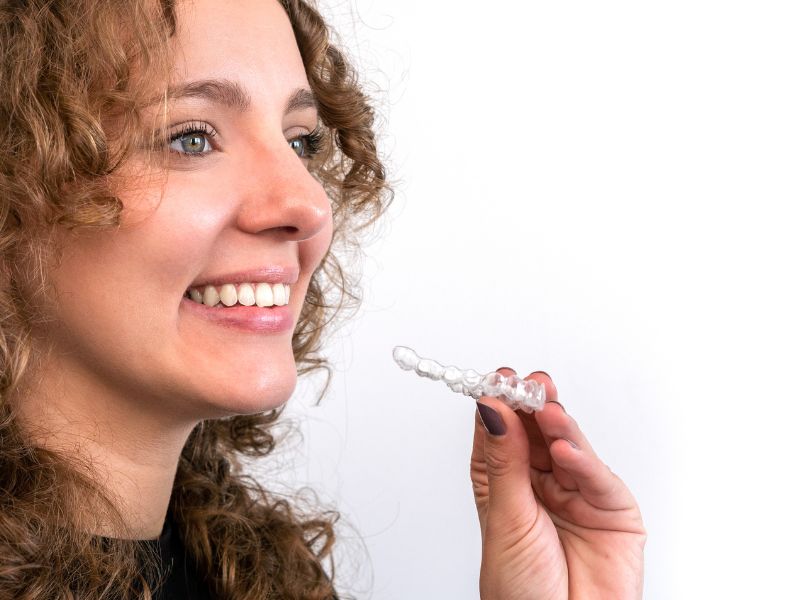How Invisalign Works: A Guide from Fine Dentistry of Downtown Orlando

How Invisalign Works: A Guide from Fine Dentistry of Downtown Orlando
Malocclusion, which includes crowding, spacing, and bite problems, goes beyond how it looks. It can cause plaque to build up, make gum disease more likely, and wear down enamel or strain the jaw too soon. Genetics, losing teeth early, and habits from childhood, like sucking your thumb, can all cause teeth to become misaligned. Adults may also have shifting teeth because of bone loss or missing teeth.
In the past, orthodontic correction only used metal brackets and wires. These methods work, but they often require visible appliances, limited diets, and trouble keeping your mouth clean. Clear aligners have become a good choice for patients who want a less disruptive solution, especially for those with mild to moderate problems.
Choosing Between Braces and Clear Aligners
Both traditional braces and clear aligners are used to fix the position of teeth, but they do it in different ways. Braces are still the best option for complicated cases with a lot of crowding or jaw problems. Aligners, on the other hand, are a more streamlined and discreet option for adults and teens who only need a little bit of alignment.
Aligners can be taken out, unlike fixed brackets. This means that patients can keep eating and brushing their teeth the way they always do. The practice's own blog says that this method works especially well for spacing or crowding problems because it lets patients deal with both function and appearance with fewer compromises.
What to Expect from the Aligner Process
A full oral exam is the first step in aligner therapy. The dental team uses digital intraoral scans to map every surface of the teeth after making sure they are healthy. These 3D images are used to make a custom treatment plan by simulating each step of movement before the first aligner is even made.
After that, patients get a series of aligners, which they wear for about one to two weeks each. These trays are made of a flexible thermoplastic that has been specially designed to put gentle pressure on teeth to move them into place. Regular visits help keep track of progress, and changes can be made as needed. In some cases, attachments or small tooth-colored "buttons" may be added to make certain movements better.
Why Many Patients Prefer Clear Aligners
Aligners are a treatment option that is almost invisible for people who are worried about how they look. Professionals and teens who might feel embarrassed about wearing traditional braces really like this benefit. Patients also find aligners easier to use than fixed appliances because they can be taken out during meals and cleaning.
Another benefit is that they are comfortable. The smooth plastic trays make it less likely that metal wires and brackets will bother you. Patients usually feel less pain when switching between aligners than when getting their braces tightened. And because digital planning is in charge of the process, treatment can sometimes be finished faster.
Important Factors to Keep in Mind
Not every case is right for aligners. Patients with more complicated dental problems, like big tooth rotations or changes in the way they bite down, may still need braces. Aligners must also be worn for 20 to 22 hours a day to work. Not wearing trays or skipping them can make treatment take longer or make the results worse.
The health of the patient's gums and bones is also important. If you have active periodontal disease, you need to take care of it before starting aligner therapy. Also, you may need to fix any existing restorations or decay first. A full assessment makes sure that treatment starts off safely and well.
Keeping Your Smile Straight Long-Term
Retainers are very important after active treatment is over. Without them, teeth may move back to where they were before, which is called orthodontic relapse. Custom retainers help keep results, and for long-term success, you need to see the dentist regularly and take care of your teeth.
Not only are aligned teeth easier to clean, but they also spread out the forces of biting more evenly. This makes it less likely that your gums will wear down or recede too soon. Patients can get better function and long-term oral health stability as well as cosmetic benefits by investing in correction now.
In Summary
Clear aligners offer a modern, patient-centered solution for correcting mild to moderate dental misalignment. With their near-invisibility, convenience, and comfort, they serve as a compelling alternative to traditional braces—especially when guided by a skilled clinical team. The process begins with a detailed evaluation and continues through a series of custom trays designed to reposition teeth gently and predictably. While patient compliance is essential, the rewards are substantial: improved esthetics, oral hygiene, and long-term function.
Ready to Take the First Step?
Call (407) 777-2071 to schedule a consultation and find out if clear aligner treatment is the right fit for your smile.
